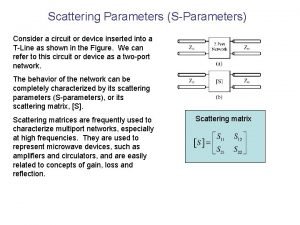Scattering Parameters SParameters Consider a circuit or device







- Slides: 7

Scattering Parameters (S-Parameters) Consider a circuit or device inserted into a T-Line as shown in the Figure. We can refer to this circuit or device as a two-port network. The behavior of the network can be completely characterized by its scattering parameters (S-parameters), or its scattering matrix, [S]. Scattering matrices are frequently used to characterize multiport networks, especially at high frequencies. They are used to represent microwave devices, such as amplifiers and circulators, and are easily related to concepts of gain, loss and reflection. Scattering matrix

Scattering Parameters (S-Parameters) The scattering parameters represent ratios of voltage waves entering and leaving the ports (If the same characteristic impedance, Zo, at all ports in the network are the same). In matrix form this is written

Scattering Parameters (S-Parameters) Properties: 1) Reciprocity The two-port network is reciprocal if the transmission characteristics are the same in both directions (i. e. S 21 = S 12). It is a property of passive circuits (circuits with no active devices or ferrites) that they form reciprocal networks. A network is reciprocal if it is equal to its transpose. Stated mathematically, for a reciprocal network Condition for Reciprocity:

Scattering Parameters (S-Parameters) Properties: 2) Lossless Networks A lossless network does not contain any resistive elements and there is no attenuation of the signal. No real power is delivered to the network. Consequently, for any passive lossless network, what goes in must come out! In terms of scattering parameters, a network is lossless if where [U] is the unitary matrix For a 2 -port network, the product of the transpose matrix and the complex conjugate matrix yields If the network is reciprocal and lossless

Scattering Parameters (S-Parameters) Return Loss and Insertion Loss Two port networks are commonly described by their return loss and insertion loss. The return loss, RL, at the ith port of a network is defined as The insertion loss, IL, defines how much of a signal is lost as it goes from a jth port to an ith port. In other words, it is a measure of the attenuation resulting from insertion of a network between a source and a load.

Scattering Parameters (S-Parameters)

Scattering Parameters (S-Parameters)












